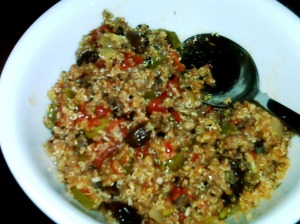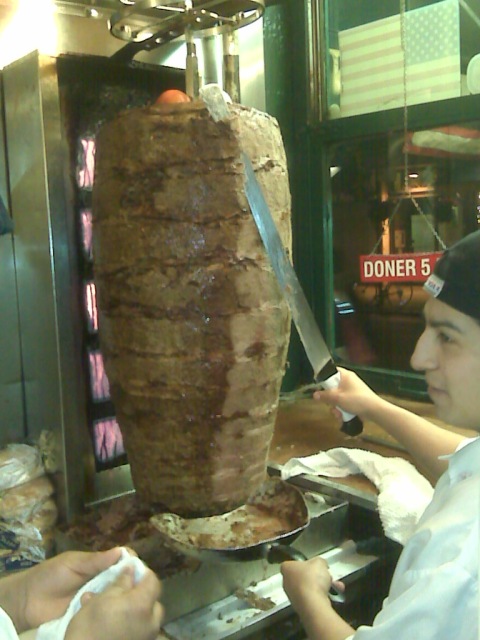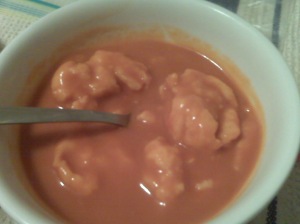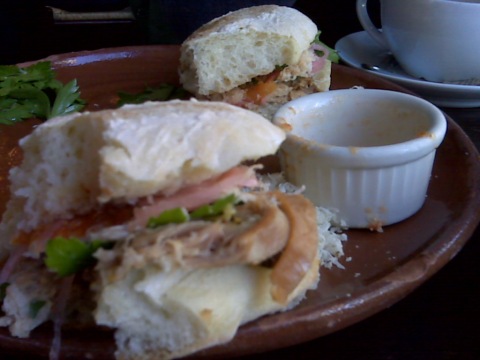Cure for an Ice Storm
January 28, 2009

I hear much of the country in encrusted in ice this week. Instead of tackling the roads for dinner, now’s the perfect time to hit up your pantry and freezer. I thought I’d provide all the shut-ins with a Caribbean-inspired recipe to get your minds off the chill.
The recipe for Quinoa Beef Picadillo, is borrowed from Lorna Sass’s cookbook, Whole Grains Every Day, Every Way. This dish tastes like a Latin-flavored chili, but with a surprise burst of flavor from sweet raisins and briny olives. This is one of my client’s favorite recipes–at one point I was making it several weeks in a row. I’m glad it’s now back in the repertoire.
A Picadillo is a Spanish stew popular in the Caribbean islands and typically made of ground pork, peppers, olives, capers and spices and served over rice. Sass’s recipe subs lean ground sirloin for the pork and a South American grain, quinoa, for the rice. You could easily make it a high-protein vegetarian meal by using soy crumbles, beans, or by omitting these altogether…read on…
Quinoa (KEEN-wah) is a small round seed that expands into a ring-shape when cooked, and packs an earthy, nutty taste with a slight crunch. It’s a unique grain in that it contains all of the essential amino acids (rice and wheat lack lysine), thus making it a complete protein and a perfect food for vegetarians. It’s also high in fiber and iron.
More good news! Quinoa is gluten free (they make flour out of it too). I love that it cooks quickly in just 11-12 minutes (the same time it takes to cook some spaghetti, which is made of wheat, which has gluten and lacks lysine, just to review).
This recipe calls for 3 cups cooked quinoa, which you will get out of 1 cup dried. I like to boil mine like pasta, no measuring necessary, so easy! Drain, fluff, and then add to the recipe where indicated. Enjoy!
Quinoa Beef Picadillo (Lorna Sass)
Serves 4-6
- 1 tbsp olive oil
- 1 large onion, diced
- 1 large green bell pepper, seeded and diced
- 2 tsp garlic, minced
- 1 tsp cumin seed
- 1 lb lean ground beef (or soy crumbles, or beans)
- 1/2 tsp salt
- 1 tsp dried oregano
- 1/2 tsp chili powder
- 1/8 tsp ground cinnamon
- 1 (28-ounce) can diced tomatoes (with green chilies, or fire-roasted), with liquid
- 1/3 cup pimento stuffed olives, cut in thirds crosswise
- 1/4 cup raisins
- 2 tablespoons capers, drained
- 3 cups cooked quinoa
- fresh ground pepper, to taste
- lime wedges, to serve
- Heat the olive oil over high heat in a large, deep skillet. Add the onion and green bell pepper and cook, stirring, until the onion is translucent, about 3 minutes. Stir in the garlic and cumin seeds and cook 1 minute more.
- Add the beef and salt, breaking the meat up into bits with a fork. Continue cooking until the beef is brown and crumbly, 3 or 4 minutes. Pour off any rendered fat.
- Stir in the oregano, chili powder, cinnamon, tomatoes, olives, raisins, and capers. Bring to a boil. Reduce the heat, cover and simmer the mixture until the flavors have mingled, about 15 minutes.
- Stir in the quinoa and adjust the seasonings, adding pepper to taste. Cook until the mixture is hot, about 1 minute more. Serve in large, shallow bowls with a lime wedge.
Don’t Drink the Mercury!
January 27, 2009
Some frightening news today about the contamination of high fructose corn syrup (HFCS) with mercury. Please check out the article on my Delicious link (Forbes.com).
HFCS is in a long, long list of processed foods and drinks. Made from chemically altered corn, this sweetener is a cheaper alternative to sugar, therefore very popular with food companies. (Note the new TV commercials claiming how this sweetener is just fine in moderation….sponsored by the corn growers whose income depends on these food conglomerates).
Health professionals and sustainable agriculture experts have been lobbying against this sweetener (and corn as a commodity) because of it’s detrimental effect on our country’s soil, crop diversity and nutritional status. So, here’s yet another argument against it’s use–MERCURY!
Don’t forget about another condition often linked to mercury (aside from birth defects and mental retardation)…autism. This is why many mothers today delay vaccinations, which have been known to have traces of mercury. This is a much debated issue. I have to wonder though, if children are becoming obese on processed foods laden with HFCS, if these same foods are causing the increase in autism. It is a loose hypothesis, but something to think about.
Vegetarians Hide Your Eyes: Behold the Doner Kebab
January 24, 2009


The Yatagan Doner Kebab Sandwich
It is finally here! Moving week is upon us! I’ve been dancing around boxes in our kitchen for weeks. Now I’m simply out of moves and prepared to eat out until next Saturday. This is probably a good time to confess that I’m still taking food photos with my Blackberry. The USB cord for our camera is currently packed in one of 20 boxes. Bear with.
So, today I had one of my “envy cravings.” This phenomenon is rooted in the inability to eat and enjoy what one prepares for her clients. This evening I prepared a leg of lamb for an uptown dinner party. And, keeping in line with the Freudian theory of envy–feel free to psychoanalyze–I headed straight for The Doner, the biggest conglomeration of lamb I have ever laid eyes on.
The Doner Kebab (or Döner Kebap, literally “rotating roast”) is a Turkish national dish made of meat cooked on a vertical spit and sliced to order. Uncooked meat (often lamb or chicken) is stacked and pressed before sliding on a spit for “broasting.” Because it cooks vertically, it bastes itself to create an exceptionally charred, crispy exterior. Yatagan restaurant (MacDougal Street, Bleecker/W. 3rd) serves its $5.50 Lamb Doner Kebab sandwich in a warm pita with onion, tomato, lettuce and choice of sauce (I choose the yogurt-garlic tzatziki).
Far from heart-healthy or sustainable, you won’t be standing in line for doner behind Dan Barber or Alice Waters. Actually in many countries the Doner Kebab is viewed in the same light as our Golden Arches, fast food best suited for a drunken binge. But as an occasional indulgence, I am a fan. I even eat them sober.
What’s for Lunch, President Obama?
January 20, 2009
Sure feels good to say President Obama! Thought I would post the Inaugural Luncheon menu and links to the recipes.
According to a press release from the Joint Congressional Committee on Inaugural Ceremonies:
“The menu, created by Design Cuisine, a catering company based in Arlington, Virginia, draws on historic ties to the presidency of Abraham Lincoln. Growing up in the frontier regions of Kentucky and Indiana, the sixteenth President favored simple foods including root vegetables and wild game. As his tastes matured, he became fond of stewed and scalloped oysters. For dessert or a snack, nothing pleased him more than a fresh apple or an apple cake.”
First Course
Seafood Stew with lobster, scallop, shrimp and black cod
Second Course
Duck Breast with Cherry Chutney
Herb Roasted Pheasant with Wild Rice Stuffing
Molasses Whipped Sweet Potatoes
Third Course
Cinnamon Apple Sponge Cake with caramel sauce and vanilla ice cream
Follow the link to download the recipes in PDF format: Inaugural Luncheon Menu
Sunday Supper: Zuppa Zolfino
January 19, 2009
(NOTE: Photos to come! Getting acquainted with our new camera…)
Sunday’s evening meal was a showcase of two Italian food gifts I received over the holidays: Tuscan Zolfino beans and Parmigiano-Reggiano cheese.
Zolfini are small whitish-yellow beans that melt in the mouth like butter, and retain their shape well after a good, long simmer. The beans are included in the Tuscan Slow Food “Ark of Taste,” which serves to preserve this and other plant varieties so they may continue to be celebrated as local cuisine.
The wedges of Parmigiano-Reggiano were cut for us by friends Walt and Megan, who had an entire wheel shipped back with them upon returning from a 3-year post in Naples, Italy. According to Wikipedia, one wheel of this stuff weighs 80 lbs. Needless to say, I have the utmost respect for their ability to maneuver this mass of dairy and tackle the logistics of cutting it into beautiful wedges. I guess if anyone has the skills, it’s a Naval flight surgeon and his brilliant wife assistant…you guys are amazing!
I decided to highlight the beans by cooking them in a simple broth flavored with onion, carrots, celery and not much else. The beans soaked up much of the cooking broth, and created it’s own richly-flavored sauce. To serve, we picked up a loaf of whole wheat 5-grain bread. I sliced off 2 thick pieces, toasted them, and then slathered with beans. I then liberally grated the cheese over the entire plate.
The recipe is below…the preparation takes just minutes, and then it practically cooks itself…just remember to start the night before. Enjoy!
- 1 onion, peeled and quartered
- 4-5 carrots, peeled, trimmed and halved crosswise
- 3 stalks celery, cut into thirds crosswise
- 4-5 cloves garlic, peeled
- 1/4 bunch Italian parsley, stems and leaves
- 1 quart low-sodium chicken or vegetable broth
- 1 cup dried Zolfino beans, or small white beans, soaked overnight (8-12 hours) and drained
- Salt and pepper, to taste
- In a soup pot (6 qt), add the onion, carrots, celery, garlic, parsley, broth and beans; bring to a simmer. Cook on low heat, covered, for 2 hours or until tender. Add salt to taste in the final 30 minutes of cooking.
- Using tongs, remove the celery and onion pieces from the pot (reserve if you wish to add back to the beans later, or else discard). Using the back of a fork, smash the carrots and stir into the beans and broth. You may smash some of the beans as well if you would like a thicker broth. Season with pepper, if desired.
Serve the beans just as they are with a heaping grating of Parmigiano-Reggiano cheese, as a crostini, or as a side for a grilled bone-in steak, Florentine-style. Add in a tossed salad and a Chianti and you’re done.
Bowl of Galuskas
January 13, 2009
 As a kid, preparing a bowl of Galuska soup was the equivalent of whipping up some mac n’ cheese–fast, easy, and comforting.
As a kid, preparing a bowl of Galuska soup was the equivalent of whipping up some mac n’ cheese–fast, easy, and comforting.
The Galuska, or flour and egg dumpling, hails from Hungary; although, I imagine they ate plenty of them in Romania since our recipe was passed down from Great Grandmother Efrosina Dobrescu, or my “Nanny”. The dumpling, which we pronounced “Ga-lish-ka,” is made from a batter that can be mixed together in minutes.
Similar in texture to Spaetzle, these dumplings cook up quickly with a doughy, stick-to-your-ribs texture. Think of this meal idea when your pantry is bare and you have a couple eggs in the fridge.
Nanny’s Galuskas
Serve in the traditional style with chicken paprikash, in a homemade chicken soup, or as I enjoyed them growing up (and last night), in a bowl of tomato soup.
- 2 large eggs, beaten
- 1/2 cup water
- 1 cup all-purpose flour
- generous pinch of salt
- In a medium mixing bowl, stir together the eggs, water, flour and salt until the batter is smooth.
- Bring water, broth, or soup to a gentle simmer. Drop the batter by a heaping spoonful, or by a 1 1/2-Tbsp ice cream scoop, into the hot liquid. Allow dumplings to cook until they rise to the surface (you may need to gently stir if they do not rise after 2 minutes). Once they have floated to the surface, cook another 2-3 minutes. Enjoy!
The 2009 Pantry: Lose the Bouillon
January 8, 2009
Check out this Mark Bittman article about bringing your pantry up to speed for 2009.
The Minimalist: Fresh Start for a New Year? Let’s Begin in the Kitchen
Village Au Revoir
January 6, 2009
Here’s a short compilation of favorite dining and drinking spots we plan on hitting up before the big move to Brooklyn. All 10 destinations are less than 10 minutes from our front door…for 25 more days.
Without a doubt, I’m anxious to get acquainted with the dining scene that awaits us in the new hood; but, like any new relationship, it’s going to take effort. Many first dates. For now, I’m going to enjoy the fruits of my labor, having–through much trial and error–identified consistently tasty & cheap destinations in and around the village.
So cut & paste this handy list into your memo pad, and you will never be hungry again when bound by West 4th, Houston, 2nd Ave and 7th Ave.
- Joe’s Pizza (Carmine, Bleecker/W. 3rd): Plain Pie and its glorious crust
- ‘Ino (Bedford, 6th Ave/Downing): Truffled Egg Toast, delicious coffee & OJ
- Dosa Cart (Washington Sq Park South): Mixed Vegetable Uthappam (pancake) with all the condiments
- The Dove (Thompson, 3rd/Bleecker): Happy Hour! The Olympia, French Lavender
- Bianca (Bleecker & Bowery): Fritto Misto, Lasagna, Tagliatelle alla Bolognese
- The Olive Tree (MacDougal, 3rd/Bleecker): Middle Eastern Platter, Hot Borscht
- Crosby’s (Relocating from Elizabeth, Bleecker/Houston to ??): The Suzy Special, weekday lunch
- Great Jones Cafe (Great Jones, Lafayette/Bowery): Spicy Bloody Mary, Burger, $3 draught happy hour
- Jane (Houston, Thompson/LaGuardia): Brunch! Benedict Johnny, Challah French Toast, Bloody Mary
- Sea Thai Restaurant and Bistro (2nd Ave, 4th/5th St): Drunk Man’s Noodle
2009: Still Year of the Pig
January 1, 2009
 Welcome 2009! After an extremely tame night of revelry, my first craving of the new year was not coffee, advil and a greasy spoon, but a Cuban sandwich. However, considering the zero-degree windchill, I was open to other sandwich options on our arctic hike back home. Walking down the sunny side of Rivington Street, we saw some open tables at ‘Inoteca, Italian sandwich heaven. We shared a meal of some of our ‘Ino and ‘Inoteca favorites from years past, the Truffled Egg Toast, Gamberetti with Pancetta Agro Dolce, and White Bean soup. And no time like the present to indulge in a pork trend of 2008, the porchetta sandwich. ‘Inoteca uses Vermont Quality Meats pork, and serves it hot on thick slices of ciabatta with parsley-pickled onion salad, tomato relish and grated fresh horseradish (that I confused for grated cheese until my nostrils started burning). As you can tell from the photo, my mouth beat out the camera to capture this one.
Welcome 2009! After an extremely tame night of revelry, my first craving of the new year was not coffee, advil and a greasy spoon, but a Cuban sandwich. However, considering the zero-degree windchill, I was open to other sandwich options on our arctic hike back home. Walking down the sunny side of Rivington Street, we saw some open tables at ‘Inoteca, Italian sandwich heaven. We shared a meal of some of our ‘Ino and ‘Inoteca favorites from years past, the Truffled Egg Toast, Gamberetti with Pancetta Agro Dolce, and White Bean soup. And no time like the present to indulge in a pork trend of 2008, the porchetta sandwich. ‘Inoteca uses Vermont Quality Meats pork, and serves it hot on thick slices of ciabatta with parsley-pickled onion salad, tomato relish and grated fresh horseradish (that I confused for grated cheese until my nostrils started burning). As you can tell from the photo, my mouth beat out the camera to capture this one.
